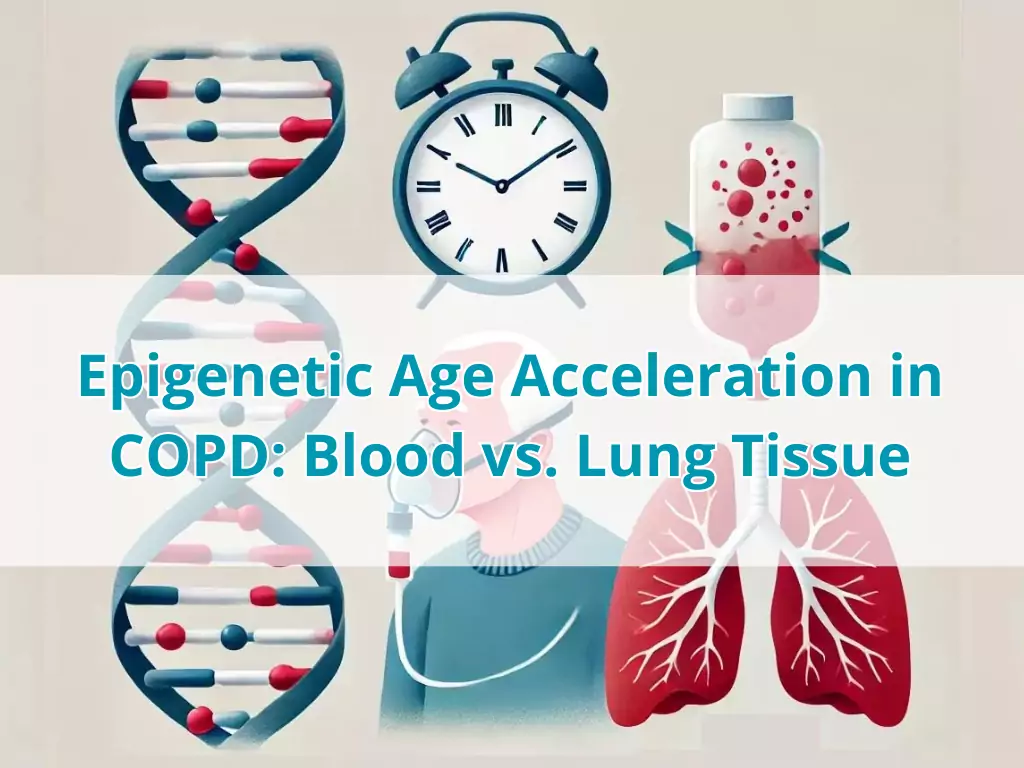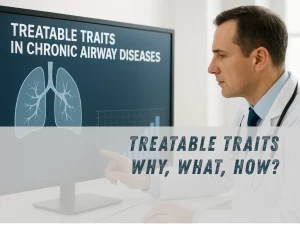Epigenetic age acceleration and severity of airflow limitation on blood and lung tissue of COPD

Introduction: Understanding epigenetic age acceleration and severity of airflow limitation on blood and lung tissue of COPD
Accelerated lung aging has been proposed as a mechanism underlying chronic obstructive pulmonary disease (COPD).
The relationship between aging markers in lung tissue and blood of COPD patients and how these markers vary with the severity of airflow limitation remains unclear.
This study explores these questions using DNA methylation-based aging calculation algorithms, known as epigenetic clocks, which are designed to measure the biological age of various tissues.
Methods: DNA Methylation and Epigenetic Clocks
In this study, DNA was extracted from blood (n=168) and lung tissue (n=138) of COPD patients with different degrees of airflow limitation severity (FEV1% ref.).
Genome wide DNA methylation was assessed with EPIC arrays (Illumina), and the biological age and age acceleration was computed with 7 epigenetic clocks, and with the mDNA-TL estimator (a Telomere length shortening measure).
Multivariable linear regressions adjusted for chronological age, sex, pack-year and smoking status, were used for the analysis.
Results: The Impact of Airflow Limitation Severity on Biological Age in COPD Patients
The results showed that in blood, airflow limitation severity was associated with the biological age acceleration determined by three epigenetic clocks (BLUP, Levine, DunedinPACE) and by the mDNA-TL estimator.
By contrast, in lung tissue only the mDNA-TL estimator showed a significant association with the severity of airflow limitation.
Conclusion: Distinct Patterns of Aging Biomarkers in Blood and Lung Tissue of COPD Patients
The findings indicate that COPD patients with more severe airflow limitation present a higher biological epigenetic age acceleration only in blood.
However, both blood and lung tissue of these patients present an accelerated Telomere shortening.
These findings suggest that the pace of aging biomarkers is different in the two tissues.
Authors
J. Viglino, S. Casas-Recasen, N. Olvera, T. Garcia, A. Agusti, R. Faner
Read more details at
Noticias relacionadas

Symptoms, risk of future exacerbations, and response to long-term macrolide treatment in bronchiectasis: an observational study
Observational study shows bronchiectasis symptoms independently predict exacerbations and identify patients who benefit from macrolide therapy, even with few prior episodes.

Treatable Traits. Why, What, How?
Discover how the Treatable Traits approach transforms the management of asthma, bronchiectasis, and COPD through personalized precision medicine strategies.

Diagnostic Metabolomic Profiling of COPD as Potential Biomarkers in Older and Younger Patients
Study identifies 10-metabolite panel distinguishing COPD from healthy subjects with ~90% accuracy, highlighting lipid metabolism dysregulation and offering new diagnostic insights.
Artículos
COPD
- 759578·Alberto Papi et Al.-Relationships between symptoms and lung function in asthma and/or chronic obstructive pulmonary disease in a real-life setting: the NOVEL observational longiTudinal studY
- 759785·Richard Beasley et Al – Prevalence, Diagnostic Utility and Associated Characteristics of Bronchodilator Responsiveness
- 759788·Alvar Agustí, Rod Hughes, Eleni Rapsomaki, Barry Make, Ricardo Del Olmo, Alberto Papi, David Price, Laura Benton, Stefan Franzen, Jørgen Vestbo, Hana Mullerova – The many faces of COPD in real life: a longitudinal analysis of the NOVELTY cohort
- 759883·Alberto Papi, Rosa Faner, Ian Pavord, Federico Baraldi, Vanessa M McDonald, Mike Thomas, Marc Miravitlles, Nicholas Roche, Alvar Agustí. – From treatable traits to GETomics in airway disease: moving towards clinical practice
- 768799·Surya P Bhatt Richard Casaburi Alvar Agusti et Al. Chronic obstructive pulmonary disease: hiding in plain sight, a Statement from the COPD Foundation Medical and Scientific Advisory Committee
Imagen desarrollada desde DALL-E y editada en Canva
